by Louis H-P
June 28, 2021 Updated October 23, 2023
1006
3 votes
Reading time: 1 minutes
The firm's main research and development office is based in Tel Aviv Israel. It originally specialized in Forex and indices spreadbetting and CFDs but has recently expanded in stock trading also.
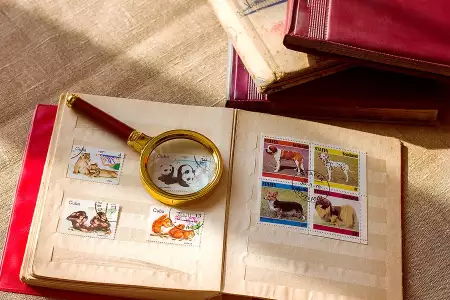
In this article, we discuss how much money can be made in stamp collecting. While few get rich through stamp collecting, those who do become immensely so.
Returns are unpredictable, but this hobby provides social support for investing while pursuing whatever other interests you fancy.
It is now also being taken up by the financial media, and a diverse and inclusive demographic as well as an impressive array of influencers! If you do hit big from stamp collecting, your potential profits could be absolutely surreal.
At the time of writing, eToro has 2.2 out of 5 star on Trust pilot. The comments suggest that the platform offers some impressive features but withdrawing money can be difficult. Having said that, some of the negative reviews appear to be rants rather than constructive criticism. This can be examples of traders losing money through their own recklessness rather than eToro's fault. You should therefore take this reviews with a pinch of salt. OANDA is a global financial services company providing advanced currency solutions to both retail and corporate clients all over the world. In this article, we are going to review this broker’s trading options, tools, platforms, spreads, commissions, security measures, and educational resources to help traders make the right choice. AvaTrade offers a wide variety of trading solutions (spread trading, CFDs, and social trading), and peace of mind with its comprehensive regulation, covering the EU, Australia, Canada and South Africa. Clients can use a variety of platforms for discretionary and automated trading.![]() Best Award Winning Brokers
Best Award Winning Brokers Show Search Filters
Show Search Filters
76% of retail investor accounts lose money when trading CFDs with this provider.
76.6% of retail investor accounts lose money when trading CFDs with this provider. You should consider whether you understand how CFDs work and whether you can afford to take the high risk of losing
76% of retail investor accounts lose money when trading CFDs with this provider.
What’s the biggest return you ever made on an investment?
If you bought Tesla stock (Nasdaq:TSLA) at its 2010 IPO, according to Investor’s Business Daily, then sold it at its January 2021 peak, you made 18,318% on your money.
Stamp enthusiasts love to tell the story of the British Guiana 1c Magenta. It is not much to look at. Smithsonian Magazine’s Alex Palmer describes it as “a red-wine stain or a receipt that’s been through the wash a few times.” But over decades it has become an object of desire, envy and immense value for stamp collecting aficionados.
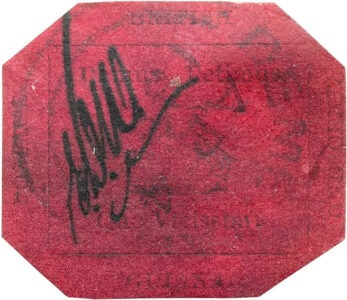
The tale starts in 1856 when the postmaster of the British colony – now the independent Co-operative Republic of Guyana – found himself with only 10% of the stamps London had promised him. So he printed up provisional ones – counterfeits, some might say – which were retired and destroyed a few weeks later once the official stamps were finally delivered.
And that would be the end of a short-yet-still-boring story had it not been for Vernon Vaughan, a Scottish boy residing in British Guiana. In 1873, at age 12, he stumbled across one of these stamps among his late grandfather’s papers and sold it for quite a profit: six shillings.
It traded hands several times over the next five years before ending up in the collection of German aristocrat and preeminent philatelist Philipp von Ferrary. The nobleman died during the First World War and bequeathed his entire collection to a Berlin museum. Then France expropriated it all, including the Magenta, under terms of the Versailles Treaty.
The Third Republic sold it off to a collector in New York, who sold it to another in Australia – the fourth continent this single 1c stamp found itself.
And it just kept traveling.
In 2014, Sotheby’s auctioned it off for $9.5 million to an anonymous bidder. That’s roughly what a thousand average Guyanese make in a year today, according to Salary Reporter.
That bidder turned out to be Stuart Weitzman, who can afford it. He designs $1 million-per-pair shoes for such divas as Beyoncé and Taylor Swift. The net of it is: This stamp is the most expensive in the world. Somebody paid one cent for it in 1856 and now it is worth almost $10 million. Do the math, and you will see that it has appreciated by about 1 billion per cent.
If you start a stamp collection, you are unlikely to be a success story.
Even so, you are not the only one reading this article, nor did this stem from projections based on a single example. Blame it on the pandemic, but last year some hundreds of thousands of beginners – at least – took up the hobby of collecting rare stamps.
The Wall Street Journal’s Andrew Nelson reports that, between March and June 2020, search results for the American Philatelic Society doubled.
“Chalk it up to an affinity for nostalgia combined with a desire to escape digital life, similar to other blast-from-the-past trends like vinyl or cottagecore,” Alexia Dellner writes for PureWow, further noting that:
“a quick search on Instagram revealed over 300,000 #philately posts and 118,000 #stampcollection pictures. That’s more than #oatmilk (228,888) and #millennialpink (a measly 75,647).”
She reports similar results for #stamp on TikTok. Here, then, is how you can get started with stamp collecting and catch up to the early adopters.
The Magenta was discovered geographically close to the newspaper press where the series was printed, and it had cancellation marks and a postal official’s initials on it, which were standard local practice. There was little doubt about its authenticity from the get-go, and any remaining doubt could be removed by trained analysis. Here a high-level view of what experts look for to weed out phonies:
Many stamps have perforated edges so, if you see one without perforations, it is fake. Alternately some issues are, to use the term of art, imperforate, so bad forgers might forget that and perforate their handiwork.
As self-adhesive stamps replaced the gum Arabic-backed ones, printers found that such separation methods as diecut or rouletting were preferable. But getting back to perforation: Some stamps also have perforated insignias, or perfins, punched through the middle as a fraud prevention tactic.
The entire process of plate making, engraving, etching and related functions that produce a stamp can be determined by forensic clues. Odds are, the forger will not have the same printing resources as a sovereign government’s postal service.
Not only is the stamp’s ink identifiable, so is the ink used for the postmark or cancellation.
Often, the adhesive gum backing the stamp is applied in a specific pattern which is difficult to duplicate.
In the 19th-century United States – and few other times and places – stamps were embossed with grills, each with a different pattern. Most grills point the dents down, but some point up. Most have vertical ridge patterns, but some have horizontal ones. Only a good forger knows these patterns and can emulate them.
Just like currency notes, stamps are printed with special ink on special paper with watermarks and silk threads. There might be secret marks that are only visible in certain lighting or under a microscope.
By the way, there is a difference between a forgery – meant to defraud collectors – and a counterfeit – meant to defraud the government that issued them.
If you think about all the meticulous work it takes to credibly reproduce a stamp, it hardly seems worth the effort to avoid paying a few pennies. As obvious as it is now, it was almost as obvious back in the days from 1840 to around 2000 when a network of national postal services was the primary medium for long-distance communication.
Today’s era equivalent is Facebook, Twitter, TikTok and Verizon Wireless rolled in one, and national postage services owned all of Amazon’s delivery trucks. Many reasonable people would have no moral qualms about pilfering a little of that organization’s revenue, but it was simply too much work to try.
Counterfeiters generally had non-financial reasons for their exertions, and they often had to do with psychological warfare. One of the leading authorities on stamps as weapons of war is retired U.S. Army Sgt. Maj. Herbert A. Friedman, for whom the European theater of World War Two was of special interest.
Describing an American clandestine operation code-named Cornflakes, Friedman reports, “The idea was to drop mailbags over the site of trains that had been attacked and derailed. The mail, containing propaganda material from the Allies, would then hopefully be delivered by the Germans to the addresses on the fake envelopes” bearing either fake stamps printed in Allied territory or genuine ones smuggled out of Germany.
It did not work. Neither did a British attempt to cause a schism in the Nazi Party by issuing counterfeits replacing Adolf Hitler’s face on the 66 Pf. stamp with that of Heinrich Himmler. Part of a broader misinformation campaign in 1942-43 insinuating the SS commander intended to undertake a coup, it did not fool anyone at the Reichspost. Still, you will pay upwards of $1,000 for the Himmler fake today.
Of course, forgeries can be worth something too – if they are from the right forgers.
The all-time champion was Jean de Sperati, who spent the first half of the 20th century creating fakes. These had such verisimilitude that, when he shipped a package of falsified Nazi German stamps from Paris to a revenue stamp dealer in Lisbon, the Occupied French authorities arrested him for violating capital export controls. This had overtones of collusion with the enemy, considering such actions as Operation Cornflakes were taking place at the time.
Sperati “declared that they were not genuine, but reproductions that he had simply forgotten to mark as such,” Rob Lammle recounts in Mental Floss. “To verify his claim, two separate aps panels of experts were brought in and, after thorough examination, the stamps were declared genuine.
But to prove they were fake, Sperati created four more perfect copies for the court, who then instead charged him with fraud, a lesser crime. After years of legal arguments, the trial ended in 1948 with Sperati convicted and fined, not even for fraud, but for ‘disturbing the normal routine of the French customs service.’
After the war, the British Philatelic Society bought his entire collection for $320,000, adjusted for inflation, just to ensure they never again circulate. To this day, you can find Speratis selling through legitimate channels for hundreds or even thousands of dollars each.
Today in the so-called art investing Non Fungible Token age, it is getting hard to say exactly what makes any collectible worth a given amount of money.
But with stamps, as with NFTs and coin collecting, it all begins with provenance – the chain of custody, if you will, linking its point of origin with each of its subsequent owners. As the following table suggests, the fact that a stamp was once in Ferrary’s collection often enhances its resale value.
| Est. 2021 value | Image | Stamp | Origin | Distinction | Notes | Famous owners |
|---|---|---|---|---|---|---|
| $10.2m |  | 1c Magenta | British Guiana, 1856 | Provisional; one-of-a-kind; octagonal shape | Phillip von Ferrary, John E. DuPont, Stuart Weitzman | |
| 7.1m |  | Bordeaux Cover “Post Office” | Mauritius, 1847 | Intaglio-process pair; first British Empire stamps printed outside Great Britain | Ferrary, Elizabeth II | |
| $3.9m |  | 1c Franklin Z Grill | U.S., 1868 | Unique embossment (grill pattern Z; horizontal ridges) | Bill H. Gross | |
| $3.7m |  | Treskilling Yellow | Sweden, 1855 | Coloring error | only one known to exist – although there are rumors of more | Ferrary, Carol II of Romania, Armand Rousso |
| $2.6m |  | Error of Color | Two Sicilies, 1859 | Coloring error, excellent condition | ||
| $2.0m |  | The Whole Country is Red | People’s Republic of China, 1968 | Taiwan isn’t colored red, matching reality but contradicting party line | ||
| 1.6m |  | Inverted Jenny | U.S., 1918 | Mail plane (“Jenny”) appears to be flying upside down | Block of 4 is worth $5.2m | |
| $1.6m |  | 9 Kreuzer Error | Baden, 1851 | Color error, inverted number (9 should have been a 6) | Ferrary, Baron von Türckheim | |
| $1.2m |  | 24c Declaration of Independence | U.S., 1869 | Fine-detailed art reproduces John Turnbull’s famous painting | ||
| $1.2m |  | Blue Boy | Alexandria, present-day Egypt, 1946 | One-of-a-kind; circular design | ||
| $1.1m |  | 3c Washington B Grill | U.S., 1867 | Unique embossment (grill pattern B; dents point up) | ||
| $1m |  | Hawaiian Missionaries Dawson Cover | Kingdom of Hawaii, 1851 | Fragile pelure paper | ||
| $890k |  | Red Revenue $1 Small | Qing Dynasty China, 1897 | Block of 4; text too small to read; intaglio printing process | Related sheet of 25 stamps valued at $18.8m | M.D. Chow |
| $700k |  | Plate 77 Penny Red | U.K., 1861 | Perforation error | ||
| $700k |  | Tiflis | Present-day Georgia, 1857 | Embossed, metallic, oldest Russian Empire stamp |
There are, of course, other factors to consider when looking for value in stamp collecting. These include:
The table shows a lot of issues from the 1850s. That is because history does not precede that decade by much. The British Penny Black, which appeared in 1840, is considered the first postage stamp.
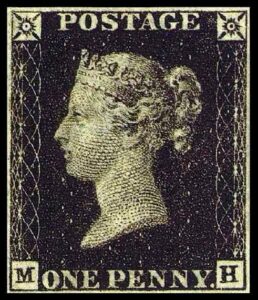
While the Magenta was not much to look at, it did have a unique color and shape, and the silhouette of a ship in the background was a nice touch. The printer apparently added as a lark, because it is not in the design of the stamp the Magenta copied. Meantime, the 24c Declaration of Independence is a true masterpiece, with detail so fine you need a magnifying glass to see it.
If you have ever collected anything else, you might think that – other things being equal – an unused stamp is worth more than a used one. After all, a doll that is still in its box or a comic book that is still in shrink wrap is worth more on eBay than one that has been played with or read.
And that is generally true with stamps, but not always. A stamp that is pasted onto an envelope – “on cover,” in the parlance – with a postmark could be worth more than a pristine stamp. Extra credit if it is a first-day cover, that is, if it is postmarked the same day it was issued.
While the preference remains for mint-condition, uncirculated stamps, it should also be pointed out that those stamps which have seen their value go to the moon have mostly journeyed through a couple post offices.
Remember that air conditioning was invented many decades after postage stamps were, and that not every issuing nation is in an adhesive-friendly climate. Stamps would often lose their original gum to the elements, or it would melt all the way through the paper and ruin the front.
Either of these occurrences would lower the stamp’s value. But it is often the collectors themselves who ruin the gum – and thus the entire stamp – by being careless placing it in an album page.
There is no real reason why, but this is still true: Stamps that are perforated on only two or three sides and worth less than those perforated on all sides. So picture a sheet of 20 stamps – a 4×5 rectangle. It yields 14 stamps along the edge. Thus it might be imperforate on one or two sides, like the flat sides in a jigsaw puzzle. Only the six interior ones would be perforated on all sides. None of the outer 14 could likely be worth as much as the inner six.
Overprints are like reverse postmarks. While a postmark is an additional layer of text and graphics indicating a stamp cannot be used again, an overprint indicates that a stamp can be used.
Overprints were originally used as a security measure in places where stamps were stolen somewhere between the press where they were printed and the post office where they were to be distributed. These marks have since been used to adjust stamp prices as a result of inflation or to commemorate occasions of national pride or for many other purposes.

Just because a used stamp has a long and storied history, is aesthetically well-designed and satisfies all those criteria that only serious stamp nerds understand does not mean it is valuable.
The price of anything is a matter of supply and demand and, in most cases, there’s more than enough supply. So what makes a stamp rare or, better yet, unique?
How many were printed, and how many survive to this day? While the Penny Black and the England Wins are worth far more than their face values, they were both printed in great number and both have thousands of extant copies. For the price of a stamp to go to the moon, there has to be some novelty to it.
It might never be worth millions of dollars – or hundreds or even tens of thousands – but it is still valuable. More than 41,000 were printed and quite a few are still around. Depending on the condition, you could spend up to $40,000 for one today.
While it is considered rare, its value also stems from other factors. The 1845 issue was one of the oldest in the world, the first to be printed in three colors. It was also issued by a Swiss canton rather than by Switzerland as a confederation, and designed by Melchior Berri, the architect who also designed much of Basel’s skyline.
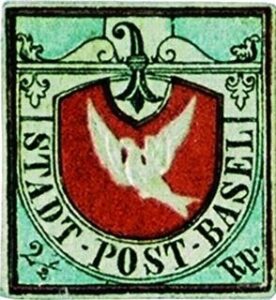
Even so, what often makes a stamp unique is that some printer, somewhere along the line, got it wrong. His mistake was not caught until the issue was circulating. Collecting up the mistakes and disposing of them was someone else’s job, though, and that person was more diligent.
As a result, only a relative handful of those erroneously printed stamps remain in private hands. The most frequent mistake is probably using the wrong color ink, but you could see a number of ways that can happen.
A more egregious error is inversion. The most famous is the American Inverted Jenny stamp, in which a biplane appears to be flying upside down. At least that goof was entirely aesthetic. If you bought it in 1918 and did not understand that it would be an instant collectors’ item, you could still treat it like a 24-cent airmail stamp.
An arguably worse error was committed in 1851 by some poor soul in Baden, who was told to print up stamps worth 6 Kreuzer. He inadvertently flipped the character and printed up a bunch of 9 Kreuzer stamps. He got the color wrong too.
Thanks to those professional lapses, the Inverted Jenny and the 9 Kreuzer are among the Top 10 most expensive stamps in the world today.
There is a difference between philately and stamp collecting. Philately is the substantive study of postal stamps and postal history. Stamp collecting is just what the term implies. It is possible to be a philatelist without being a stamp collector. For example, if you are a curator of a museum exhibit focused on stamps.
It is also possible to be a stamp collector who just buys a sheet of every new issue that comes out. Still, the Venn diagram would have a huge field of overlap between these two populations. But let’s proceed with the premise that you intend to be a stamp investor, so you will want to know how to assess and protect the condition of your stamps.
Stamps are graded pretty much the same way as wine. The item starts with a numeric score of 100, and points are deducted for each quality shortfall. With reference to Linn’s Complete Stamp Collecting Basics, let’s take a look at the factors:
Stamp assessors like it when the owner carefully, deliberately separates one stamp from its sheet. They prefer to see nice, even rows of teeth and take away points if the stamp was just ripped away in a rush.
Bends, creases, scuffs, stains and tears diminish a stamp’s value, especially if you’re dealing in mint-condition stamps. Since collectors tend to keep their stamps in albums, they need to be very careful about how they do it or they’ll damage the gumming.
Hinges – the sleeves that hold stamps in albums – have their own adhesives, so sometimes they sap the gum off the stamp. Also, sometimes the gum saps the adhesive off the hinge. Both outcomes are bad for the stamp’s value.
There is no broad agreement on what is an aesthetically pleasing postmark. There is a dispute between those who think the lighter the cancel the better, because it interferes less with the design of the stamp. Others want it dark enough to clearly discern the date and location.
What is generally agreed is that a postmark should not be so heavy as to be distracting. Stamps that are canceled by a pen are less valuable. Of course, if something is so distracting it becomes notable in its own right, that could add value.
The exemplar is the “running chicken” cancel offered in 1869 by the postmaster of Waterbury, Conn. An envelope with this bit of flair is worth about $400 on its own.
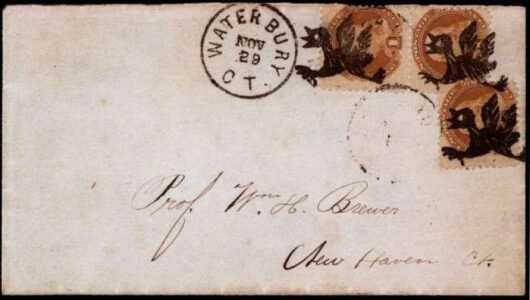
Over the decades, there have been different ways to print a stamp: offset, gravure, intaglio and so on. Each has its own set of rules. Ultimately, the print should be as loyal to the design as possible. Getting the colors correct is especially important. As we have seen, getting the colours wrong can increase a stamps value!
Even the best printing job, though, will not keep colors from fading as ink is exposed to the elements. Collectors need to keep their stamps out of daylight and away from chemicals.
Oddly enough, this is where a lot of points are lost. It is apparently very difficult to center every stamp on a sheet perfectly within the margins. Oh, and the margins cannot be too big or too small.
Based on all these criteria, according to the New York-based Philatelic Foundation, Superb (S, 98+ points), Extremely Fine (XF, 90+) and Very Fine (VF, 80+) are considered investment-grade.
Your first instinct is – but last resort ought to be – going to an appraiser. They are expensive, and the stamps you have to show probably do not merit it. Save that for when you have got something to sell at auction.
The best place to start is online. Assume your stamp is in VF condition and see what it is going for on eBay or other marketplaces. Incidentally, while eBay is a great place to sell your stuff, you ought to be careful about buying there. Pricing is sketchy through some vendors, and you need to be diligent about ensuring the claimed provenance is for real. In his Journal article, Nelson cites hipstamp.com and mysticstamp.com as better online options.
Such reference books as the Scott Standard Postage Stamp Catalogue, updated annually, is a good source for a reality check, especially for U.S. stamp issues. Throughout the rest of the anglophone world, the Stanley Gibbons series of U.K., Commonwealth and British Empire guides is essential.
But remember that this is supposed to be a social hobby, not a solitary endeavor. Go out to stamp shops and stamp fairs. If there is no stamp club in your location, you could join an online group. Any of these person-to-person contacts will yield a trove of information about the value of your stamps.
Investing in stamps is a little like investing in stocks, crypto or any other commodity. Make sure you are in a liquid market. While you will find stamp collectors in every country, there is a marked concentration in the U.S, U.K and Germany, according to Florida-based appraiser Treasure Coast Stamps.
Of course, interest in British tradition and American pop culture are nearly universal, so there is a great affinity for these nations’ stamps throughout the English-speaking world. Do not overlook Australia, Canada or New Zealand. These are all markets with lots of buyers, lots of sellers and certainly no shortage of inventory.
Also – and maybe we would not have said this 10 years ago – do not ignore China. The hobby seems to be catching on there and two of the 12 most valuable stamps originated there – one during the Qing dynasty and one since the establishment of the People’s Republic.
Those are the places to buy contemporary stamps which, sad to say, it is unlikely that you will stumble across a major quality control snafu. But these are the countries where you will have the most opportunity to buy, sell and trade.
Which brings us to where to buy stamps. There are a lot of options, which is not surprising considering that there are an estimated 30 million collectors generating annual revenue of $10 billion.
The most immediately obvious answer is your local post office. While you are picking up stamps to use to send out greeting cards – those are called definitive stamps – you can also pick up sheets of commemorative issues.
Be forewarned, though: Buying commemorative stamps is a labor of love, not an investment. These are almost always printed up in volumes exceeding demand and rarely ever exceed their face value.
In any sizable town, there is likely to be a shop specializing in the stamp trade. If you are looking to sell your assets quickly for cash – and you are not concerned about getting the full market price, this is the most likely option. Still, someone else’s distress can be to your benefit. Dealers generally try to sell stamps for double what they paid, so a buyer might be able to drive a bargain.
The truly fun part of buying stamps is going to auctions. Have you ever been to an art or collectibles auction? Then you know. You have not? Trust us. Go. Just do not forget your price discovery guide.
Just about every week of the year there is a major stamp fair somewhere in the world, at which dealers staff booths as they look to sell you their wares.
Even before we were all connected via social media, there was a worldwide network of philatelic investors. Nobody knows for sure just how big this decentralized market is.
You can also get them stamps for free. Your friends and family might start looking at you funny, but you can always ask them to save stamps from letters they receive.
What is missing from this list, of course, is an organized exchange. The market simply does not lend itself to the kind of bourses that deal in securities.
Just like there is no such thing as a “typical” stock investor, there is no such thing as a “typical” stamp collector. Stock buyers favor either growth or value, or they base their decisions on either momentum or fundamentals. You must choose what you intend to acquire.
Let’s take a stepwise approach:
It is best to build your collection around something that already interests you: wildlife, sport, music, history, what have you. Chess grandmaster Anatoly Karpov, for example, is obsessed with that greatest disaster of European colonialism, and collects stamps originating in Belgium and the former Belgian Congo.
“You have a pile of stamps, and you start arranging them by country,” Dominic Savastano of the Spink auction house told the BBC’s Serena Renner. “Some of course are turned upside down and you realise this one has grilled gum [patterns in the adhesive] on the back from Czechoslovakia! Stamp collecting is very much an aesthetic hobby. You buy stamps because you want to enjoy looking at them.”
Just like with any other assets, you need to understand both their underlying value and their market dynamics. While a good catalog can help you with current prices and there is no shortage of books that can explain what to look for. These will be more thorough than this article can, none of this addresses the role momentum plays. For that, you really need to participate in the market.
Of course, “the basics” of stamp collection also includes how to spot fakes. This is something we touched on above under the “Stamp terminology – different parts of a stamp” heading.
In the following section, “How to store stamps,” we’ll begin the discussion of the equipment and skills you will need. This will ensure you can acquire and curate an array of stamps to call it a collection. More importantly, this will enable you to keep your assets from harm. It is easy to inadvertently diminish their value through carelessly damaging them.
Determine which dealers, auction houses, stamp fairs or principals-only arrangements you will be engaging with. Take the time to understand the pros and cons of each. Then – and only then – involve yourself with buying and selling stamps as an investment rather than as a hobby.
Once you buy and hold single stamps with some appeal to you personally, it is time to learn the rubrics of how to maintain your collection.
In addition to the stamp catalogs we noted earlier, the American Philatelic Society recommends that you invest in these tools at the very least:
Along the way, you will learn how to use all these. You will even learn how to remove a stamp from an envelope without damaging it. You will become a past master of adding stamps to albums without compromising the gum.
As a result, you might even reach the point where your collection is valuable enough to take out insurance on and share it at stamp shows.
It really is possible to parlay a stamp collection into a fortune.
“The value of collectible stamps of all classes has proved remarkably resilient to fluctuations in the broader economy over the years,” according to John Greenwood at The Telegraph, who cited the 10-year period at the cusp of the Great Recession, over which stock prices fell, and yet an index of collectible stamps rose 245%.
And yet, it is no passive investment. There are rules to follow.
According to Stanley Gibbons, there are currently 20 million stamp collectors in the world today. It is a fun hobby, which is social, affordable and educational. You just might make some money at it if you are lucky.
And yet Philatelic investment is not for everyone, and it is not for all purposes. It is a good idea to weigh the positives and negatives before committing to it as part of your financial strategy. Bear in mind, a lot of the pluses are not quantifiable.
You have got an app for trading stocks, making crypto transactions and placing sports bets. If you want to buy and sell stamps, though, it involves physically handling them and exchanging them with real, live people. If you consider this a “con” rather than a “pro,” maybe you should stop right here.
Celebrities have been collecting stamps for as long as that’s been a thing. John Lennon, Freddie Mercury, Ronnie Wood, Amelia Earhart, Charlie Chaplain, Jacques Cousteau and others have all checked for grill marks. So have more contemporary notables as Maria Sharpova and Patrick Dempsey. While interest might be waning in the West, stamp collecting appears to be on an upswing ins south and east Asia.
Right now, while the global economy is on an upswing, stamps are a fairly sleepy place to be. But come the next downturn, it will become a frothy market as collectors find themselves needing to raise cash. Further, stamps might outperform during inflationary times.
If you follow the technology, then you’re all in on NFTs. Stamps are, in a very real way, NFTs without the blockchain. The current gold rush into digital assets might be sapping the stamp market. This gives savvy buyers the opportunity to get in at a time of depressed prices.
Nothing is guaranteed, the future is uncertain and there’s no authority regulating the market.
Whether you’re buying or selling – or, for that matter, just holding – philatelic investing is more expensive than most other markets. Also, these taxes might involve sales tax. And we haven’t yet mentioned the cost of expert appraisal.
The stamp market amounts to tens of billions of dollars per year. The securities and foreign exchange financial markets are measured in terms of trillions of dollars per day. Further, it might take days or weeks to sell a single stamp.
Imagine the value added by having celebrity names in the provenances of stamps you own. Now stop imagining it and make it happen. Still, it is important to realize that this glitterati have already made their money and do this to relax.
Very few people – famous or otherwise – who have lives outside of stamp collecting make a lot of money at it. You would require equally copious amounts of luck and preparation to fall into a philatelic fortune.
Treat it as a pastime that gets you in a room with other people who share your passion. You will also bond over the excitement that comes with auction bidding and with making friends around the globe.
Stamp collections can be worth money, depending on various factors such as rarity, condition, age, and historical significance. The value of individual stamps or an entire collection can fluctuate over time based on market demand and other factors.
To determine if your stamps are valuable, research their rarity and condition. Consult stamp catalogs, online resources, or expert advice to learn about rarity, and examine your stamps closely for any imperfections that may affect their value.
The word for stamp collecting is “philately.” Philatelists are individuals who collect and study postage stamps, postal history, and related items.
About the author:
William Freedman writes about business, technology and finance for such news outlets as Global Finance, Macrotrends and AlphaSense, and for blogs such as those of American Estate & Trust, Sharestates, and KV Capital. He holds an MBA in international finance from The American University in Washington, D.C., and serves on the board of governors of the New York Financial Writers’ Association.

